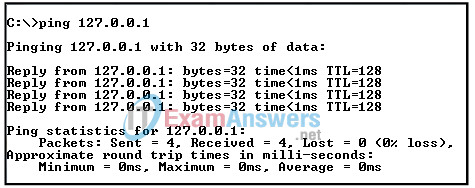1. What are the differences between binary and decimal numbers? (Choose two.)
- Decimal numbers are based on powers of 1 and binary numbers are based on powers of 2.
- Binary numbers are based on powers of 2 and decimal numbers are based on powers of 10.
- Computers use binary numbers and people normally use decimal numbers.
- Numbers typed on a keyboard are entered as binary and converted to decimal by the computer.
- Binary numbers consist of three states: on, off, null. Decimal numbers do not have states.
2. Examine the graphic with current configurations. Host A in the Clerical office failed and was replaced. Although a ping to 127.0.0.1 was successful, the replacement computer cannot access the company network. With proxy ARP disabled on the Fa0/0 interface of the New York router, what is the likely cause of the problem?

- network card failure
- network cables unplugged
- IP address incorrectly entered
- subnet mask incorrectly entered
3. Refer to the exhibit. A network administrator is testing the configuration on a host computer. What type of address is 127.0.0.1?

- link-local
- loopback
- public
- default route
4. What portion of the IP address does the prefix represent?
- broadcast
- host
- network
- unicast
5. Which is true regarding IP network addresses?
- all host bits are set to 0
- all host bits are set to 1
- assigned the highest address in a range
- all network bits are set to 1
6. Which address type has all host bits set to 1?
- network
- broadcast
- host
- unicast
7. How many binary digits (bits) are in an IPv6 address?
- 64 bits
- 48 bits
- 128 bits
- 32 bits
8. What is the primary reason for development of IPv6?
- security
- header format simplification
- expanded addressing capabilities
- addressing simplification
9. Refer to the exhibit. The numbers in the exhibit are part of a single subnet. Which statements are true regarding these numbers? (Choose three.)

- Their final octet has 4 of the most significant bits in common.
- They have 5 low-order bits in common.
- They have 27 high-order bits in common.
- 192.168.223.99 is a feasible network number for their range.
- 255.255.255.224 is an appropriate mask for their range.
- 192.168.223.127 is the broadcast address for their range.
10. Drop the options on the left to the correct target on the right.

